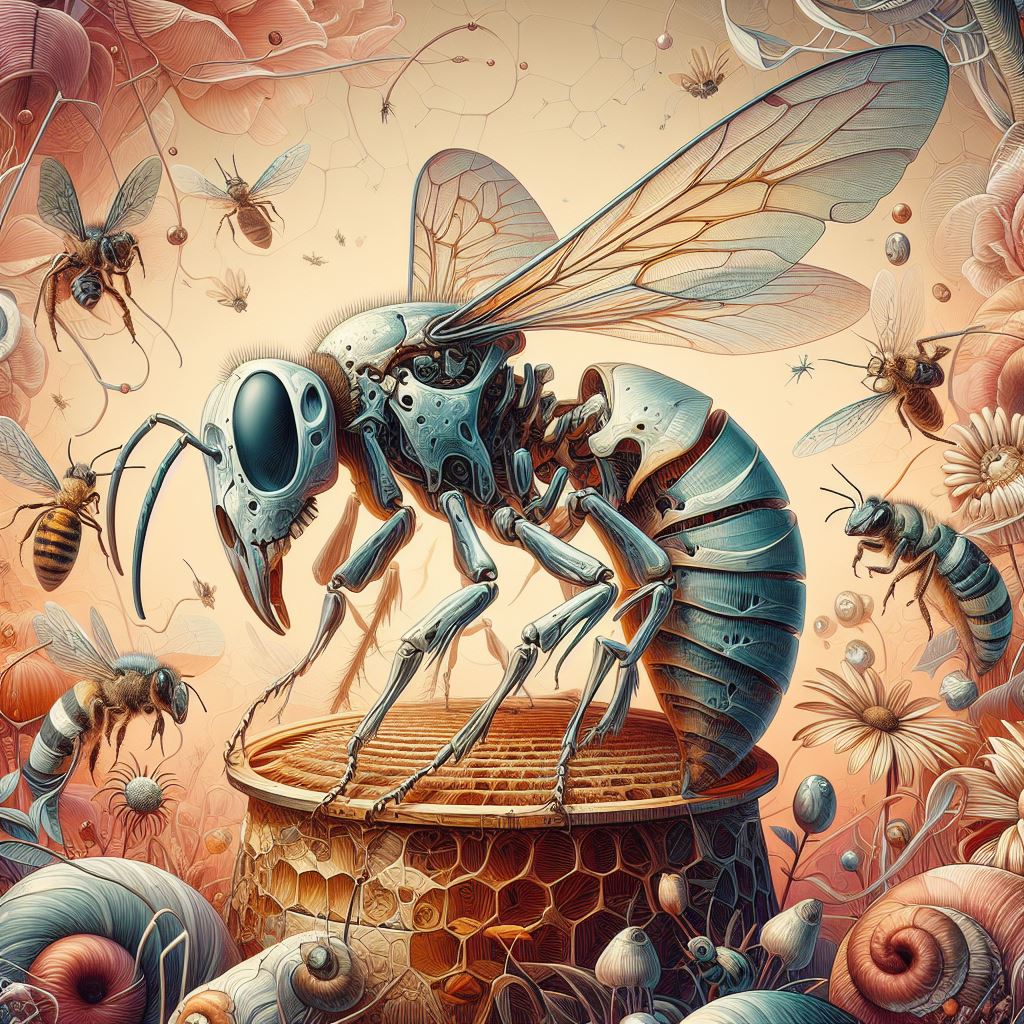Key Takeaways: Bee Anatomy Insights
- Exoskeleton Structure and Function
- Bees lack traditional bones but possess an exoskeleton made primarily of chitin. This external skeleton serves as armor, providing support and protection for the bee’s body. It allows for flexibility, precise movement, and sensory perception, essential for tasks such as foraging and hive maintenance.
- Explanation of Bee’s Lack of Traditional Bones
- Unlike vertebrates, bees do not have internal bones. Instead, their exoskeleton made of chitin and sclerotin serves as their skeletal system. This unique adaptation contributes to their exceptional flight capabilities, agility, and efficiency in navigating their environment.
- Support Structures in Bees
- Chitin and sclerotin play pivotal roles in bee anatomy, providing strength, flexibility, and support for the bee’s body. The exoskeleton, reinforced by these substances, enables bees to perform essential tasks such as carrying pollen, building combs, and flying with precision. While bees lack traditional bones, their exoskeletons are finely tuned adaptations that showcase nature’s ingenuity in crafting solutions for different organisms.
A Glimpse into the World of Bees

Brief Overview of Bees and Their Anatomy
Ah, the sound of bees buzzing in the summer air is delightful. These tiny creatures have a fascinating world inside them. Bees are insects with six legs, four wings, and three distinct body parts.
The honey bee is the most famous. It’s crucial for pollination and making honey. When we think of bees, we see them buzzing around, collecting nectar and pollen.
Have you ever looked closely at a bee’s body? Their compound eyes and internal skeletons are amazing. Bees are truly remarkable creatures.
The outer surface of a bee’s body is covered by a protective exoskeleton made primarily of chitin. This rigid outer layer provides support and protection for the bee’s internal organs.
Under their hard outer shell, bees have muscles wax glands, and connective tissues. These help them do tasks in the hive. Inside a bee’s body are organ systems. They work together smoothly to keep the bee busy.
Bees have special air sacs in their breathing and respiratory system. Their digestive system turns nectar into honey. Bees are marvels of nature’s engineering. When you see a bee with pollen on its legs, think about the amazing complexity inside its small body.
Bee Anatomy Basics

Exoskeleton Structure and Function
The bee’s exoskeleton is akin to a suit of armor. It helps honey bees in safeguarding their delicate internal organs from harm. Crafted primarily from chitin, a resilient and pliable material, this exoskeleton is strong. It offers structural support but also serves as a barrier to predators and other threats. This exoskeleton stretches from the bee’s head to its thorax and abdomen below. This external skeleton forms a durable layer, ensuring protection throughout the bee’s body.
One fascinating feature of the bee’s exoskeleton is its ability to grow. It follows suit with the bee’s abdomen as it matures. Unlike humans, bees do not have bones that stop growing once they reach adulthood.
Queen bees grow by shedding their exoskeletons periodically. This growth process is crucial for their survival. It allows them to accommodate their increasing size and thrive throughout their lifespan.
The exoskeleton helps bees move precisely. It’s where muscles attach. Each part of the honey bee head exoskeleton connects to muscle pairs. These muscles work together to move the bee.
When flying or when collecting pollen or nectar, the bee depends on its tough exoskeleton. It supports and coordinates its movements. Besides protection and support, the exoskeleton helps with sensing things.
Small hairs on the exoskeleton sense temperature, humidity, and texture. These cues are crucial for navigating, communicating with other bees, and finding food.
The exoskeleton is vital for bees. It helps them survive and thrive as pollinators. Its many functions show how bees are designed. This highlights their ability to adapt and succeed in different environments.
Skeletal System in Bees
When it comes to the skeletal system bee anatomy of bees, one might wonder: do bees have bones? The answer is quite fascinating. Bees lack traditional bones like humans or other vertebrates.
Bees have an external skeleton called an exoskeleton. It’s tough and made of chitin. This material supports and protects the bee’s body.
Bees’ exoskeletons help them keep their shape and help protect their insides. It covers their whole body, just like bones do in other animals.
Explanation of Bee’s Lack of Traditional Bones

Bees don’t have regular bones because they’re insects. Insects, like honey bees, evolved with an external skeleton made of chitin. These differ from having internal bones like mammals.
This exoskeleton serves multiple purposes beyond just structural support for wings. The lack of traditional bones in bees’ wings also aids in their lightweight and efficient flight capabilities.
Bees are renowned for their remarkable flying abilities. Their lightweight bodies, devoid of heavy bones, enable them to navigate swiftly through the air. The absence of bones enhances their overall agility and flexibility. This allows them to perform intricate maneuvers with ease.
Bees often navigate tight spaces in hives or flower petals while foraging. Their flexible exoskeletons let them twist and turn easily. Unlike rigid bones, this flexibility helps bees move freely.
Though bees don’t have bones like humans, their exoskeleton made of chitin is crucial for their skeletal system. This adaptation helps bees thrive in different environments. It also lets them play important roles as pollinators and honey makers in ecosystems.
Support Structures in Bees
Chitin and Sclerotin Roles in Bee Structure
When it comes to the intricate design of a bee’s body, chitin and sclerotin play pivotal roles. Chitin is a tough, flexible material that makes up the exoskeleton of bees.
The exoskeleton is like armor, protecting bees from harm. Sclerotin, a protein, adds strength and stiffness to parts like the wings and legs of honey bees.
These substances make a strong framework that supports the body cavity and bee’s organs. The exoskeleton, made of chitin, protects female bees. It also attaches muscles to the body.
ChatGPT
Bees’ muscles help them fly smoothly through flower fields. Chitin’s flexibility lets bees move precisely while staying strong.
The tough exoskeleton, strengthened by sclerotin, is crucial for bees. Without it, they couldn’t do tasks like carrying pollen or building combs. Chitin and sclerotin also help bees move efficiently.
Worker bees use their specialized structures to carry pollen and collect nectar and pollen. They can also make wax for comb building. These structures help them do these tasks smoothly. The coordination between muscles and chitin lets worker bees perform vital hive tasks.
Chitin and sclerotin show how nature designs organisms for their environments. Bees have evolved unique structures suited to their lives as pollinators and hive inhabitants. Other insects may have different exoskeleton compositions.
Fun Fact: Bee’s Unique Body Adaptations

How bees’ lack of bones aids in flight efficiency
When pondering the question of whether bees have bones, it’s interesting to note that they don’t have traditional bones. Instead, bees rely on their exoskeletons, made of chitin and sclerotin, for support and protection. This absence of an internal skeleton contributes significantly to their exceptional flight capabilities. The exoskeleton, while lightweight, provides bees with a sturdy structure. This allows them to maneuver swiftly and with agility through the air. This unique adaptation showcases nature’s ingenuity. It does so by equipping bees with the tools they need to thrive in their environment as pollinators and hive inhabitants.
The streamlined design of bees enables them to move easily while they travel between flowers in search of nectar and pollen. Additionally, the lack of bones in the front legs of bees is important for their ability to generate strong lift when flying.
Bees beat their wings rapidly, up to 200 times per second, using up to two pairs of wings. Their flexible exoskeleton efficiently transfers energy from muscles to wings. This interaction causes a propeller-like twist motion. This helps in propelling bees swiftly and accurately through the air.
It’s an incredible example of natural engineering. Unlike most insects and vertebrates with internal skeletons, bees don’t deal with constraints. These constraints are things like gravitational effects on bone density or weight distribution.
Without skeletal limitations, bees have unparalleled freedom of movement in the air. This allows them to perform intricate aerial maneuvers with incredible agility and finesse. The absence of traditional bones in their hind legs and wings isn’t a hindrance. Instead, it’s a crucial adaptation that contributes to their exceptional flight efficiency.
Comparison to other insects with exoskeletons
When thinking about bees having bones like other creatures, it’s important to compare their body structure with other insects. Many insects have chitinous outer coverings for protection. However, each species has unique adaptations. Unlike bees, some insects have thicker or more rigid exoskeletons for better defense.
For instance, beetles have tough exoskeletons with curved hairs and multiple layers for protection. They resist punctures and crushing well. On the other hand, butterflies have delicate wings supported by veins in their exoskeletons. These veins help them fly gracefully and display vibrant patterns during courtship.
Each insect group evolved unique adaptations in their exoskeletons for survival, reproduction, or movement. While bees lack bones, their external skeleton gives them advantages in-flight efficiency and agility over other insects.
Conclusion
In the world of bees, the question “Do bees have bones?” directs us back to the hive within their hive for insight into their anatomy. Though they lack traditional bones, bees possess an exoskeleton that supports and protects them. They use chitin, sclerotin, and muscles to move through their hives and collect nectar.
As we think about bees not having bones and admire the intricate support structures that help them survive, we see how nature has given these small creatures amazing adaptations. Bees not having traditional skeletons show how well they’re designed and how natural selection works wonders.
When observing a worker bee or bees as they diligently collect pollen or construct honeycombs with precision, one can’t help but appreciate the intricacy of their physiology. The absence of bones in bees contributes not only to their agility in flight but also highlights the interconnectedness between structure and function in the insect world.
While pondering the question “Do bees have bones?” may spark curiosity about these buzzing creatures, it ultimately unveils a world where adaptability reigns supreme. Bees have thrived for millions of years without traditional skeletal components, relying instead on a finely tuned exoskeleton that serves as a testament to nature’s ingenuity.
So next time you see a bee buzzing by, remember that beneath its delicate wings lies a complex system perfectly tailored for its vital role in pollination and hive life. While bees may not possess conventional bones as humans do, their resilient anatomy showcases nature’s ability to craft diverse solutions for different organisms.
The absence of internal skeletons does not hinder these remarkable insects; rather, it propels them forward as vital contributors to our ecosystem. Let’s take inspiration from bees’ adaptability and resilience as we continue to explore and appreciate the wonders of our natural world.
Neutralize Bees with D-Termination: The Leading Pest Control in Las Vegas!

Dealing with bee problems on your Las Vegas property? Trust D-Termination to help. Our skilled team specializes in eliminating bee infestations, restoring comfort and peace to your space. Bid farewell to bees—choose D-Termination for effective pest control today!
Reach out to us at 702-919-6310 or visit dtermination.com to schedule your bee control service and reclaim your space from these bothersome insects.
Frequently Asked Questions:
Yes, bees have a heart, although it’s a simple one.
Bees don’t have bones; their bodies are exoskeletons made of chitin.
Bees have a circulatory system, but it doesn’t function like human blood.
Yes, bees have brains, although they’re relatively small compared to mammals.







